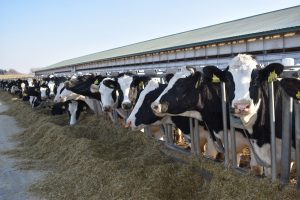
What comes up for you when reading this statement:
“We are extremely excited to expand our joint venture with Chevron to construct and operate 10 new, intensely carbon-negative renewable natural gas projects on dairy farms across the country and continue to reimagine waste,” Bob Powell, CEO and founder of Brightmark, told me.
Excitement about seeing another climate solution scaled? Are your greenwashing alarm bells going off? Just a big question mark?
For me, it was an “all of the above” type of situation when I read the announcement last week. Time to untangle some of it.

Dairy farms can produce biogas by feeding cow manure into anaerobic digesters. Microorganisms in the digester’s oxygen-free (anaerobic) environment break down the organic matter. This decomposition creates biogas which gets cleaned up and processed into biomethane, a gas that can be used as fuel for trucks, buses and cars. Sometimes, the gas is also converted to electricity and fed into the grid. A dairy cow produces a lot of manure — about 112 pounds per day — making it a quickly renewing and naturally occurring feedstock, which means that the end product is a renewable natural gas.
Why does it matter?
Some are excited about producing natural gas on dairy farms because it significantly reduces methane emissions. Methane will play an important role in our climate future. It is a short-lived and extremely potent climate pollutant that stays in the atmosphere for about 12 years. A pound of methane heats up the atmosphere 25 times more than a pound of carbon dioxide does, which is why it’s extremely important to quickly reduce its emissions.
Agriculture has a big role to play here. In California, for example, over half the state’s methane emissions come from livestock, cows in particular. They mostly emit methane through burps but also when their manure breaks down in lagoons. The latter can be circumvented by converting manure into biomethane instead of storing it.
As this process avoids methane emissions that would otherwise occur on dairy farms, California considers it a carbon-negative technology under its Low-Carbon-Fuel Standard (LCFS). California has invested $288.9 million in dairy digesters and other manure management approaches, funding about 60 new projects over the past five years.
Powell of Brightmark goes a step further, telling me that the projects he executes in collaboration with Chevron and farmers are “intensely” carbon-negative. The fuel received a lower carbon intensity score within California’s LCFS program than solar or wind as the production depends on a lot less infrastructure. The projects also help farmers supplement their incomes while allowing for less nitrogen runoff when they apply manure to fields after it has dried while going through the biodigester.
So far, so climate-friendly?
Things get trickier here. Yes, biodigesters avoid emissions. But this doesn’t necessarily make them a clean energy source or a good use of public funding. Andrew DeCoriolis, executive director at Farm Forward, told me via email: “Like ‘clean coal’ or BP’s rebranding itself as ‘Beyond Petroleum,’ biogas greenwashes a polluting and inhumane industry, all while financially benefiting the largest meat companies in the world. The best way to reduce the environmental impacts of factory farms is to limit [their] growth and support alternative food production methods.”
Biomethane helps fossil fuel companies put off their own emissions reductions as they make their fuel mix look greener.
What’s behind this statement? First, whether dairy-based biogas is carbon-negative depends on where one draws the boundary of the assessment. The captured methane constitutes only a small fraction of the overall emissions large dairies produce — after all, most of a cow’s methane takes the form of burps, not excretion. Depending on the same animal and the same farms, this larger fraction of the overall emissions is necessarily part of the product’s overall lifecycle. Second, as the additional income makes dairy farms more profitable, it may lead to an expansion of farms and thus eventually to more emissions overall.
Another more indirect consequence critics have pointed out in the past is that biomethane helps fossil fuel companies put off their own emissions reductions as they make their fuel mix look greener.
Ultimately, should we support it?
This leads me to a more fundamental question: Should we support climate approaches that are effective in cutting emissions in the short term but extend the impact and legacy of inherently unsustainable industries such as oil and factory farming? Or should we dig deeper?
To be honest, I struggle with a straightforward answer to this question myself. I don’t believe we should create any further path dependencies for these industries. Yet I’m aware of the urgent need to employ every scalable solution we have available to avoid even more catastrophic planetary warming.
What I do feel strongly about, however, is not using scarce public dollars for industries that can and must assume responsibility themselves for their pollution. Every food and agriculture company should reduce its emissions as fast as possible and using technologies such as biodigesters might be a part of its strategy. The cost should be built into their business models just like any other expense, not outsourced to the public.
Ideally, decarbonizing industry and internalizing associated costs would happen simultaneously around the globe to avoid propping up low-cost and high-polluting farms elsewhere. But change needs to start somewhere. Based on its climate leadership on other issues, California might be better positioned than many other regions to spearhead it. In my view, the state would have been better off investing the $288.9 million supporting better manure management into helping dairy farmers transition to an entirely different business model while supporting the growth of plant-based alternatives.

























